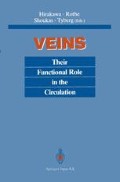Abstract
To determine the hydraulic conductivity and permeability of macromolecules across capillary and venular walls in the rabbit tenuissimus muscle, we developed a new fluorescence vital microscope in which a pair of well-defined slit laser beams (10–50 μm in thickness) were focused, so as to cross in a chosen depth of the tissue region and to excite the fluorescent tracer intensively at the crossing portion adjusted to the focal plane of the objective. After injecting a fluorescent tracer (FITC-Dextran: FD40, 70, 150; M.W. = 40 000, 70 000, 150 000) via the jugular vein, temporal changes in the tracer concentration within the cross-illuminated portion of the muscle tissue were recorded as fluorescent intensity alterations. We calculated the diffusive (D) and convective (V) components of the extra-vasated tracer by best-fitting the experimental curve with the simulation model based on the “Pore theory”, in which macromolecules are assumed to pass across the vessel wall through the “Large pore” passively buy diffusion and convection. Diffusion permeability (Pd) and hydraulic conductivity (Le) were determined from D and V values obtained at the centre and venular end of capillaries to compare their differences. The values of Pd at the venular ends were approximately 10 times greater than those at the centre but V values at the venular ends were only about two-fold greater than those of the central capillary. The mechanism bringing about such discrepancy was discussed.
Access this chapter
Tax calculation will be finalised at checkout
Purchases are for personal use only
Preview
Unable to display preview. Download preview PDF.
References
Hudlicka O (1984) Development of microcirculation: capillary growth and adaptation. In: Handbook of physiology, Sec 2, Vol 4. American Physiological Society, Bethesda, pp 165–216
Harlan JM (1985) Leukocyte-endothelial interactions. Blood 65: 513–526
Becker AY, Ritter AB, Duran WN (1982) Analysis of microvascular permeability to macromolecules by video-image digital processing. Microvasc Res 38: 200–216
Renkin EM (1985) Capillary transport of macromolecules: pores and other endothelial pathways. J Appl Physiol 58: 315–325
Rippe B, Kamiya A, Folkow A (1979) Transcapillary passage of albumin, effect of tissue cooling and of increases in filtration and of plasma colloid osmotic pressure. Acta Physiol Scand 105: 171–187
Curry FE (1984) Mechanics and thermodynamics of transcapillary exchange. In: Handbook of physiology, Sec 2, Vol 4. American Physiological Society, Bethesda, pp 309–374
Bass L, Robinson PJ (1982) Capillary permeability of heterogenous organs: a comparisoneous interpretation of indicator diffusion data. Clin Exp Pharmacol Physiol 9: 363–388
Patlack CS Rapoport SI (1971) Theoretical analysis of net tracer flux due to volume circulation in a membrane with pores of different sizes. Relation to a solute drag model. J Gen Physiol 57: 113–124
Taylor AE, Granger DN (1984) Exchange of macromolecules across the microcirculation. Handbook of physiology, Sec 2, Vol 4. American Physiological Society, Bethesda, pp 467–520
Garlick DG, Renkin EM (1970) Transport of large molecules from plasma to interstitial fluid and lymph in dogs. Am J Physiol 219: 1595–1605
Landis EM, Pappenheimer JR (1963) Exchange of substances through capillary wall. In: Handbook of physiology, Sec 2. American Physiological Society, Bethesda, pp 961–1034
Author information
Authors and Affiliations
Editor information
Editors and Affiliations
Rights and permissions
Copyright information
© 1993 Springer Japan
About this chapter
Cite this chapter
Kamiya, A., Shibata, M., Sohirad, M. (1993). Macromolecular Permeability and Hydraulic Conductivity Through Large Pores Across a Single Venular Capillary. In: Hirakawa, S., Rothe, C.F., Shoukas, A.A., Tyberg, J.V. (eds) Veins. Springer, Tokyo. https://doi.org/10.1007/978-4-431-68385-8_3
Download citation
DOI: https://doi.org/10.1007/978-4-431-68385-8_3
Publisher Name: Springer, Tokyo
Print ISBN: 978-4-431-68387-2
Online ISBN: 978-4-431-68385-8
eBook Packages: Springer Book Archive

